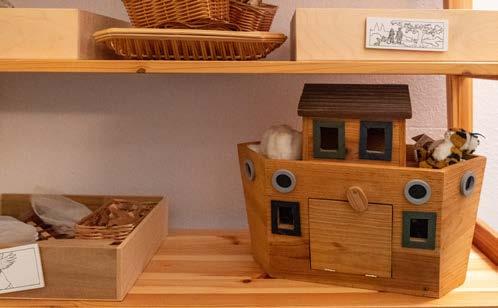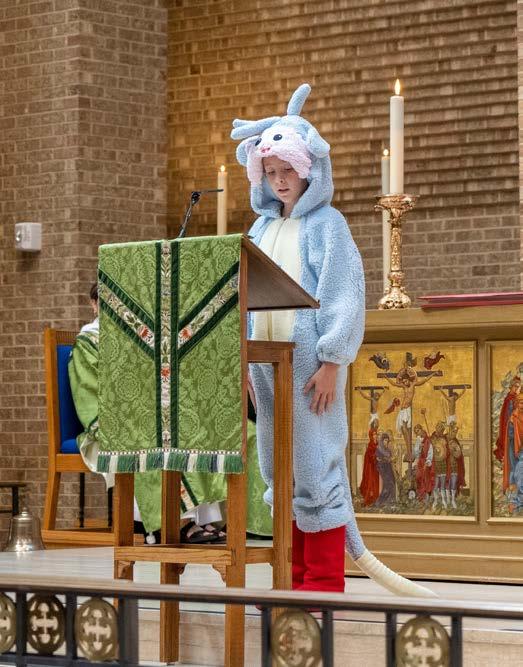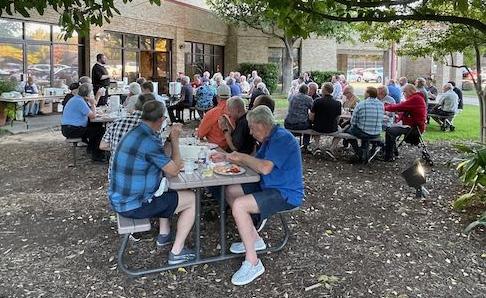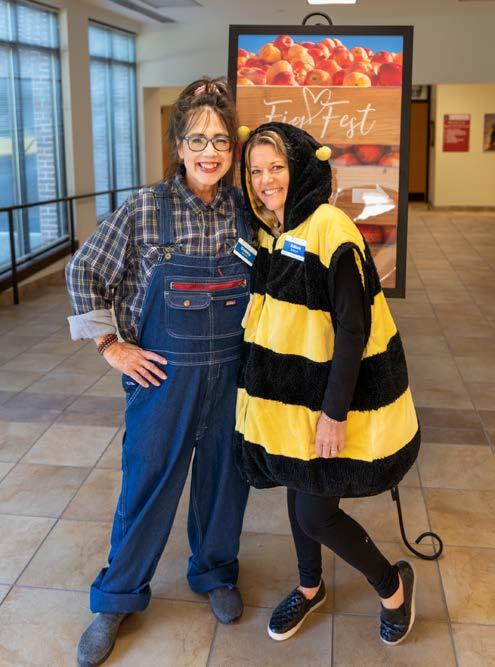ILLUMINE
enlightening and celebrating where God is at work in our midst
FALL 2022


FROM THE SENIOR 1 ASSOCIATE RECTOR

A NEW ANTHEM AND 3 AN OLD CHURCH
THE SAINT JOHN’S BIBLE 9 AT TRANSFIGURATION
READING (ALL OF) 15 MATTHEW
THE LONGEST NIGHT 16 SACRED GROUND 18
ST. HILDA’S EXPANDS 1 9 GODLY PLAY CLASSROOMS
PHOTO INDEX 23

As I take up my pen to write to you, the heat of our Texas sun has finally relented. We have remembered our saints and all of the souls we’ve loved yet see no more. The pumpkins, goblins, black cats, and scary sounds that adorned our yards over the last several weeks have given up the ghost. “Move on,” says the world, “to the next holiday!” Thanksgiving? Mother Rebecca’s birthday? No.
No, most of the world is moving rapidly toward Christmas. Here at Transfiguration, though, we are observing Advent. Our lectionary readings for the past several weeks have moved us to reflect on the Good News of Christ’s second coming. On the final Sunday of the Church’s year, we read again the story of Jesus’ crucifixion. Even as we heard the climax of the story of Jesus earthly ministry, we were pointed forward toward this second coming. As Jesus hung on the cross, one of the criminals hanging with him plead: “Jesus, remember me when you come into your kingdom.”
The word Advent, from the Latin adventus , means “coming” or “arrival.” In the four weeks of Advent, we watch and wait for Christ’s coming. For many years, my Advential watching and waiting was focused on the birth of a baby in Bethlehem, on a child in a manger, on shepherds and angels, and a star high in the sky. My watching and waiting involved decorating the house, shopping for Christmas gifts, cooking and baking for the feast to come. At the end of the season, our family would go to church and find the baby – just as the angels had promised – lying in a manger. We’d return home, having watched and waited for Jesus and having found he was indeed born on Christmas Day, and we’d celebrate with those we love.
I’ve shared with you before that, as I’ve grown older, I’ve come to understand Advent isn’t as much about watching and waiting for the birth of Christ, but for his promised second coming. Advent is a season in which we join our voices with the criminal’s and pray, “Jesus, remember us when you come into your kingdom.” When we observe Advent in this way,
as a time to prepare for the end of the story, the rhythm of our lives changes considerably. Far from decorating and feast-making, Advent becomes a time to reflect on what it will be like when, as Jesus promises, we are with him in paradise.
This is a promise worth waiting for. Here at Transfiguration, we are observing a time of holy waiting as we gather together week by week and reflect on another group of folks who watched and waited for God’s promises to be fulfilled: the magi. From our Advent Family Festival to our parish-wide adult formation classes, we’re exploring these learned Gentiles who see a star, consult prophets and sages from around the world, and find Isaiah: “Arise, shine; for your light has come, and the glory of the LORD has risen upon you.” Seeing a new star rising to their west, the magi recognize that something significant is taking place and embark on a journey. And we know the story: they bring gifts of gold, frankincense, and myrrh. The Magi have much to teach us about holy journeying and about showering those who are special with gifts.
Friends, our watching and waiting this Advent is nothing short of a gift. It is the gift of time in which we can examine our lives openly and honestly, time in which we can reconnect with our priorities and recommit ourselves to following Christ. We have so much to learn about following the Savior of the world into love. This Advent, I’m praying our collect for Epiphany – which acknowledges the leadership of the magi – and I hope you’ll join me. Let us pray:
O God, by the leading of a star you manifested your only Son to the peoples of the earth: Lead us, who know you now by faith, to your presence, where we may see your glory face to face; through Jesus Christ our Lord, who lives and reigns with you and the Holy Spirit, one God, now and for ever.
I look forward to journeying with you as we take a lesson from the Magi. Blessed Advent to you, my sisters and brothers!
Rebecca+
Ave Maris Stella was composed in 1976 during the time Trond Kverno was associated with the Gamle Aker Kirke (Old Aker Church) and Oslo Cathedral.

A NEW ANTHEM AND AN OLD CHURCH
by Joel Martinson, Director of Music & OrganistOne of the purposes of my sabbatical trip to Scandinavia last summer was to hear and to sit in on rehearsals of some of important church and cathedral choirs. I was able to experience this in all three capital cities, but what was interesting is that the three choirs I spent time with were in various stages of preparation for concerts of music from England, France, Germany, and Austria – not by Scandinavian composers! The short Danish and Swedish anthems which the Transfiguration Choir sang this fall were both sung by smaller choirs. I did hear some organ repertoire by late 19th and 20th century Scandinavians and will be purchasing music and learning some pieces to play for you in the future. A Norwegian composer that I have greatly admired for over 30 years is Trond Kverno. Born in 1945, Kverno is from the generation of composers which followed Knut Nystedt (1915-2014) and Egil Hovland (1924-2013), two important composers of Norwegian music whose work spread Scandinavian music to the rest of the world. Like Nystedt and Hovland, Kverno studied at the Oslo Conservatory of Music, and blended various elements into his music – chant, modal harmony, lean Neo-Medieval and Neo-Renaissance harmonies with Neo-Baroque contrapuntal techniques, such as ostinato (repeated musical pattern), canon, etc. I first heard Kverno’s Ave Maris Stella on a 1989 recording titled “A Rose in Winter” by the Dale Warland Singers. This Minneapolis-based professional choir was known for its singing of new music, including choral pieces from Scandinavia as well as those by Minnesota composers. Transfiguration’s own David Reece was a member of Dale Warland Singers at the time of this recording, and shared the work with Don Krehbiel, artistic

director of Orpheus Chambers Singers, Dallas’ oldest professional choir. Krehbiel programmed the work for a December concert that Orpheus sang at St. Rita during my time as director of music there.
Ave Maris Stella was composed in 1976 during the time Trond Kverno was associated with the Gamle Aker Kirke (Old Aker Church) and Oslo Cathedral. Kverno was a proponent of catholic high-church practices in liturgy and music, and often ran counter to authorities of the protestant and rather staid (Lutheran) Church of Norway of the time. This popular Latin hymn to the Virgin Mary – “Hail, Star of the Sea” – dates from medieval times, most likely the 9th century and was most often sung at Vespers. Though I purchased the sheet music for my choir at Saint Rita, and more recently for the Transfiguration Choir, neither performed it under my direction. This will all change on December 4 at 5 pm, when the work will receive its Transfiguration debut at our Advent Procession of Lessons & Carols!
Kverno’s setting of the seven stanzas of the Latin text begins with a dialogue between a choir of trebles (SSA) and a choir of basses (TBB). After each sings a stanza alone, the two choirs sing against each other in canon at a higher pitch level, then the middle stanza grows in intensity by the use of a rapid ostinato in one group against slow accented chords in the other. The piece gradually winds down in stanzas 5 and 6 until a chant-like setting of the final, doxological stanza, and an “Amen” based on the opening music conclude the piece. It is a perfect setting of the Marian text in both form and content, and one of the gems of latetwentieth century Scandinavian choral music.
On my second full day in Oslo, the day following the first post-Covid celebration of the Syttende Mai (“17th of May”) national holiday, I took a bus into the city center from suburban Oslo to begin exploring more of the Norwegian capital. I started at Oslo Cathedral and began walking up the hill to the nearest spire I could see to check if the adjoining church was open and to make note of any midweek services or concerts I could attend there. I went to the Swedish Church, Trinity Church, St. Olav Catholic Cathedral, its neighboring parish church – St. Joseph, the Oslo Cathedral’s cemetery and chapel (presently loaned to the Russian Orthodox Church) then up to the top of the hill to see the Gamle Aker Kirke. Built around 1100 this three-nave Romanesque church is the oldest existing building in Oslo, as well as its oldest church. It is also the starting point of the pilgrim path to Nidaros Cathedral in Trondheim, where faithful believers in the Middle Ages would walk 639 kilometers to visit the shrine of St. Olaf situated behind the altar.
An elderly “prest” (pastor) was giving a tour of the church to a group of teens, so the church was open and I was hoping that I could peer in when that was done, or at least when I wouldn’t be noticed. I walked around the churchyard (“kirkegård”), also dating from the 12th century, and saw the headstones from the most recent generations buried there. Early spring flowers were blooming, and the lilacs and rhododendrons were about to burst open. After a few minutes I looked back into the church to see that the tour had left the nave, so quietly crept in and felt the solemn stillness of this place which had seen nearly one thousand years of Christian worship. I imagined

what the sound of a choir singing Gregorian chant or a Renaissance anthem would be in this glorious space with its meter-thick stone walls. Later, when I heard that Trond Kverno was associated with the church around the time he composed the fore-mentioned Ave Maris Stella , I thought of how he might have “staged” the work in this ancient church, pitting the treble and bass choirs against each other from opposite sides of the nave. Soon, the tour finished, and I was asked to leave this very holy place by the prest who was anxious to lock the door behind me and get on with his day.
Two weeks later, I returned to Gamle Aker Kirke with my husband David following our sojourns in Stockholm and Göteborg, Sweden. We drove straight there after arriving in Oslo, as I wanted David to experience this church during the only time it was open to visitors outside of services, from 4 to 6 pm on Thursday afternoons. It was a joy to be back here and to have more time to explore the church, particularly the sanctuary and choir areas. I look forward to our choir singing Ave Maris Stella for you on December 4 and to the time I can return to this sacred space and hear it come alive with sacred choral music.

If you want to hear more about Joel’s sabbatical:
Please attend his Transfigured Nights presentation “Joel Martinson’s Scandinavia” on Monday, January 23, at 7 pm.
If you are on Facebook, see his personal blog “Joel Martinson’s Search for His Peeps 2022” about the first two weeks of his time in Scandinavia.


— Fr. Hilary Thimmesh (1928-2019), President of St. John’s University (1982-91)
THE SAINT JOHN’S BIBLE AT TRANSFIGURATION
by David FlickWhen, earlier this year, Elaine Culver first encountered the illuminations of The Saint John’s Bible, it reminded her of the first stunning pictures from the Webb Space Telescope. “The illuminations suggested that God was starting a conversation with me. He was asking what do you think?” she said. “The pictures of the universe from the Webb Telescope were so stunning, and I thought, ‘The creator of those things wants my opinion.’ It was such a different way of looking at it.”
Through the generosity of long-time parishioners Frances & Bob Martin and Elaine & Bruce Culver, the Episcopal Church of the Transfiguration now possesses a Heritage Edition copy of The Saint John’s Bible , one of fewer than 300 that will ever be produced.
The Bible was commissioned by Saint John’s Abbey and University, a 168-year-old institution located in Collegeville, Minnesota. The original manuscript, believed to be the first illuminated handwritten Bible commissioned in 500 years, was the idea of Donald Jackson, senior scribe to the British Crown. Jackson, born in Lancashire, England, conceived the idea as a child, publicly proposed it in 1970 and persuaded Saint John’s officials to commission the project in 1998. The first volume was completed four years later; the seventh and final volume in 2011.
There was a reason it took such a long time. Directed from a scriptorium in Wales, the calligraphers wrote each word with quill pens fashioned from goose, turkey or swan feathers. Each of the 1,150 pages took 8-12 hours. Each page was scripted on costly vellum.
Even more striking than the script are the 160 illustrations. The illustrators used gold and silver leaf and other precious metals mixed with egg yolk. They
incorporated images of women and of minority groups, who had often been ignored in the past, and they included themes of modern science and technology. An illustration depicting hell, for example, includes a depiction of the AIDS virus. A worker sowing grain wears blue jeans.
The completed manuscript now resides at Saint John’s University in Collegeville. It has not yet been bound so that pages of the original can be publicly displayed at venues around the world. When the vellum pages are finally bound together into seven volumes, the original will remain at Saint John’s University.
Aware that the intent was never to create a museum exhibit, the brothers of Saint John’s puzzled over how to share this remarkable work with the world. “If we created the original and then squirreled it away, few people could have experienced it,” said Brad Neary, director of The Saint John’s Bible Heritage Program. The brothers approached Donald Jackson with a request to create a limited run of high-quality replicas that could be purchased by churches, hospitals, schools, and families which would allow greater numbers of people to encounter The Saint John’s Bible
After extensive discussions and careful research on the best methods that could be used to reproduce faithfully the handwritten Bible, Donald Jackson agreed. Cotton paper was used instead of vellum; foil instead of gold or silver leaf. Each volume is full-sized, hand-sewn in linen, bound in Italian leather, with each of the major illuminations individually finished, so that each copy is unique. The quest for authenticity was almost obsessive. For example, the vellum in the original manuscript is so translucent that an illumination on one page shows through on the other side. Modern cotton paper blocks such show-through, yet Donald Jackson insisted that
“The calligrapher does well what many do heedlessly and hastily, what machines do mindlessly, and by cultivating the art of writing reminds us all of the pure joy of a creation good in all its designs.”

the effect be recreated in the Heritage Edition volumes. Thus, each Heritage Edition is printed with a faint watermark that mimics this effect.
Father Casey and Mother Rebecca both had been aware of the existence of The Saint John’s Bible for several years. Father Casey had encountered the Heritage Edition at a conference several years ago; Mother Rebecca first encountered it at a conference earlier this year. “Every illumination took my breath away,” she recalls. “I was awestruck. I thought, ‘We must have this!’” Returning to the display table several times over the course of that conference, she and Fr. Casey learned about a program: “A Year With The Saint John’s Bible” which would afford Transfiguration the opportunity to have the volume containing the Gospels and Acts, together with speakers from the Saint John’s community, over the course of one year.
Fr. Casey approached long-time members, Frances and Bob Martin. They loved the idea and readily agreed to underwrite our participation. Their generosity in purchasing the Bible for a year allowed a group from Transfiguration to visit Collegeville in May of this year to learn about the history and creation of the manuscript and illuminations.


While they were there, over a dinner hosted by Mr. Neary and the staff of The Saint John’s Bible , Mrs. Culver said she discussed the acquisition of a Heritage Edition with Fr. Casey and Mtr. Rebecca. “I told Fr. Casey, ‘I think Transfiguration needs one of those.’”

As Mr. Neary remembers it, he had left the table for just a few moments. When he returned, he sensed that something had happened. “Casey had a Cheshire cat look on his face,” Neary recalls. That’s when he learned that Mrs. Culver had just informed him of the couple’s decision to donate the funds to acquire our Heritage Edition.
By July, the Transfiguration volumes arrived. The Martins and the Culvers were invited to join Mtr. Rebecca and other members of the staff in a small crate opening ceremony. On Transfiguration Sunday this August, the Gospels and Acts volume made its debut in our Sunday morning services. It has been used regularly for Sunday worship since then.
This month, seven custom-made display cases were installed in our Gathering Space to serve as the permanent home for our Heritage Edition. The cases are made of wood and steel, with a modern design that reflects the architecture of the Transfiguration campus and its philosophy.
“It wouldn’t do to have a marble platform,” said Senior Warden, Mark Ramsay, who oversaw the creation of the displays. “We are a modern, forward-thinking, and progressive parish, and The Saint John’s Bible , which includes illuminations featuring the roles of women, science, and global equality, is also progressive.
Within its display, each volume will sit on a platform, angled at 20 degrees to protect its spine, encased in glass on the top and sides. The objective is that the glass protect without serving as a barrier. Lighting within and around the display cases will allow the illuminations to reflect light as they are designed to do.
In September, Mr. Neary journeyed to Dallas to conduct a three-hour training session for about 20 church members who will serve as docents. The docents were given instructions about how to handle the volumes, how to turn the pages and, especially, how to answer questions from visitors.

The acquisition has put Transfiguration in distinguished company. Other copies — only about 150 have been acquired so far — are housed at the Library of Congress in Washington, the J.P. Morgan Library in New York, Saint Martin-in-the-Fields Church in London, and the Vatican Library in Rome.
With the acquisition of our Heritage Edition of The Saint John’s Bible , Transfiguration has access to digitized images of each illumination, speakers from the Saint John’s community, and hopes to become a destination for other churches, schools, and community groups seeking to encounter this remarkable Bible.







 by Cassie Bledsoe
by Cassie Bledsoe









